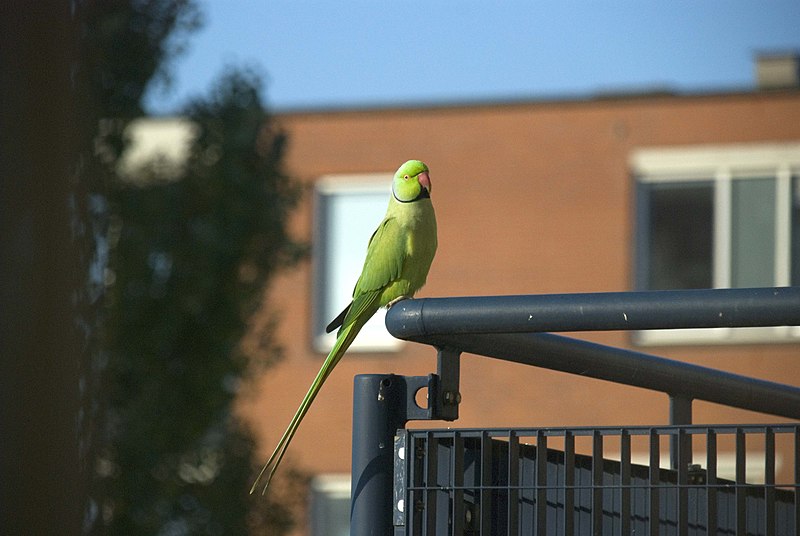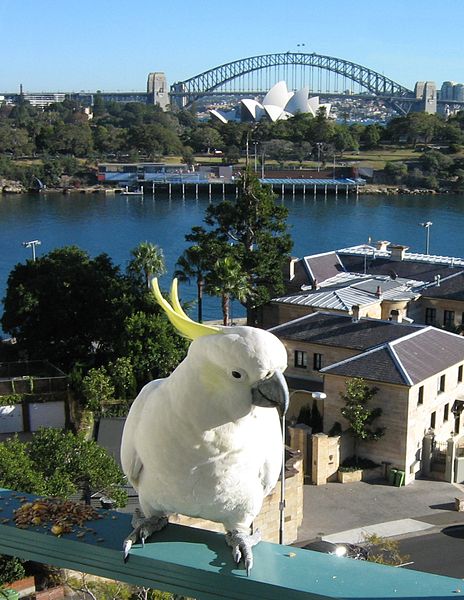 More than 50 parrot species are now breeding far outside of their native ranges. If your city or town is home to a feral (released or escaped) population of parrots, the group City Parrots would like you to help out with the World Parrot Census.
More than 50 parrot species are now breeding far outside of their native ranges. If your city or town is home to a feral (released or escaped) population of parrots, the group City Parrots would like you to help out with the World Parrot Census.
Why Study Urban Parrots
Shrinking habitats and growing human populations have forced many wild animals into close contact with people. Sometimes, such as with the Peregrine Falcons that nest in the heart of New York City, all works out well…the coyotes that arrived there recently were, however, less welcome.
Either way, there will be more of the same in the future. Studying urban and suburban wildlife, including the many species that have become established in areas to which they are not native, is vital if we are to plan for the futures of both resident and introduced species.
A Surprising Trend
Interestingly, non-native parrots usually choose cities and towns over wild habitats when they find themselves in a foreign land. Tokyo, New York City, London and dozens of others are now home to an astonishing array of species, some of which seem poorly adapted to deal with concrete, crowds and severe winters. Yet adapt they do, and usually quite handily (please see articles below).
 While many are hardy species long-known as good colonizers, such as Monk Parrots and Budgerigars, even rare and “delicate” parrots have found foreign cities to their liking. The Mexican Yellow-Headed Amazon, for example, is now breeding in Texas and, of all places, Stuttgart, Germany! Columbia’s Belem Zoo is even planning to release Golden Conures in an attempt to establish a population within the city of Belem.
While many are hardy species long-known as good colonizers, such as Monk Parrots and Budgerigars, even rare and “delicate” parrots have found foreign cities to their liking. The Mexican Yellow-Headed Amazon, for example, is now breeding in Texas and, of all places, Stuttgart, Germany! Columbia’s Belem Zoo is even planning to release Golden Conures in an attempt to establish a population within the city of Belem.
Getting Involved
City Parrot, based at the University of Leiden in the Netherlands, is interested in learning how and why so many parrots thrive in urban centers. It is hoped that lessons learned in the process will be applicable to other wild creatures that must survive in degraded or modified habitats.
It stands to reason (at least to bird enthusiasts!), that introduced parrots would be more welcome than such urban invaders as Norway Rats, House Mice or German Roaches. However, their affects on native birds has not been well-researched. Parrots seem not to be causing any major problems, perhaps because oftentimes city-dwelling animals are themselves hardy, non-native species, but we really do not know for sure. Introduced species are a major cause of extinctions worldwide, and so the issue demands attention.
 City Parrot is looking for volunteers to count parrots and to relay behavioral observations. Helping out is simple and, as I can attest from involvement with other “citizen-scientist” projects, a great deal of fun and very rewarding. Please see the article below to learn how to become involved in this very worthwhile effort.
City Parrot is looking for volunteers to count parrots and to relay behavioral observations. Helping out is simple and, as I can attest from involvement with other “citizen-scientist” projects, a great deal of fun and very rewarding. Please see the article below to learn how to become involved in this very worthwhile effort.
Further Reading
Joining the World Parrot Census.
Ring-Necked Parrots in NYC.
Psittacula krameri in Amsterdam image referenced from wikipedia and originally posted by David Evers and Snowmanradio
Cockatoo on Balcony image referenced from wikipedia and originally posted by Snowmanradio
Sulphur Crested Cockatoos Damaging Fascade image referenced from wikipedia and originally posted by Bidgee
 That Bird Blog – Bird Care and History for Pet Birds
That Bird Blog – Bird Care and History for Pet Birds




Great post! Having lived all over the country – California, Massachusetts, Florida, and Texas to name a few – I can definitely attest to the surprising population of ‘wild’ parrots living in the U.S. I have always wondered what effects the birds have on native species – hopefully this study will help us to learn more!
Hello Erica, Frank Indiviglio here.
Thanks for your interest and the kind words. I look forward to hearing from you in the future.
Good luck, enjoy and please keep me posted.
Best regards, Frank Indiviglio.
I am somewhat alarmed about parrot owners reaction to bill HR669. They are concerned that if the bill is passed their parrots will be destroyed. I did not get that impression. What is the real deal?
I understood that bill HR669 would only affect(if passed)the importation of plants & animals that would endanger native species.
As parrots are expensive & mostly bred from parrots already existing in the US it seems a moot issue. Although there MAY be some parrot owners who believe in free-flying parrots, I can’t imagine the few parrots who ‘escape’ would be significant enough to jeopardise the food chain of native birds/plants. I’d appreciate your thoughts/actual data on this issue.
Hello Elizabeth, Frank Indiviglio here.
Thanks for your interest in our blog. The internet has had both a valuable and detrimental role in this issue, so many opinions somehow transformed into “facts”. Your impression is correct – destroying pet parrots was never a consideration. Please check out this site for further info and links to the actual language of the bill.
Good luck and please keep me posted.
Best regards, Frank Indiviglio.
Hello Elizabeth, Frank Indiviglio here.
Thanks for the interesting feedback. It’s an extremely complicated issue. Actually, escaped parrots and other cage birds (Pekin Robins, Hill Mynas) have significantly affected ecosystems into which they have been introduced. The most significant problems have been in semi-tropical and tropical regions, i.e. Fla, CA and Hawaii, but the millions of Monk Parrots established in the Northeastern USA are likely having an impact. Most feral parrots take up residence near towns and cities, where the majority of the plants and animal residents are non-native, which tends to limit their influence on “natural” environments.
Another concern that is not addressed much but which is well known to biologists and zoo-folks, is the possibility that parasites and pathogens that cause only minor troubles to their natural hosts can be devastating when they become established in related species from other habitats (this is why zoos do not house related animals from different countries in the same enclosure).
Specific regulations similar to HR 669 have been in place for quite some time. For example, I was able to import only male Malaysian Leaf Insects for an exhibit at the Bronx Zoo – there’s no chance they would become crop pests in NY (especially the Bronx!) but the concern is over inter-state shipment.
Of course, pet keepers have contributed mightily to conservation, and all good zoologists started out by keeping animal collections in their homes…please see my article on this topic, as it relates to HR 669, for more info.
You might also be interested in this article on Feral Parrots In Fla.
You can learn more about the impacts of specific introduced species on the Global Invasive Species Database.
Good luck; I look forward to hearing more on this and other topics – thanks for the interest,
Best regards, Frank Indiviglio.